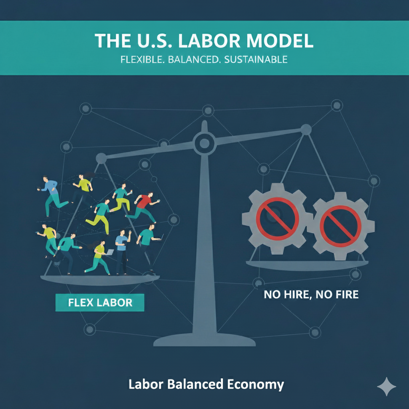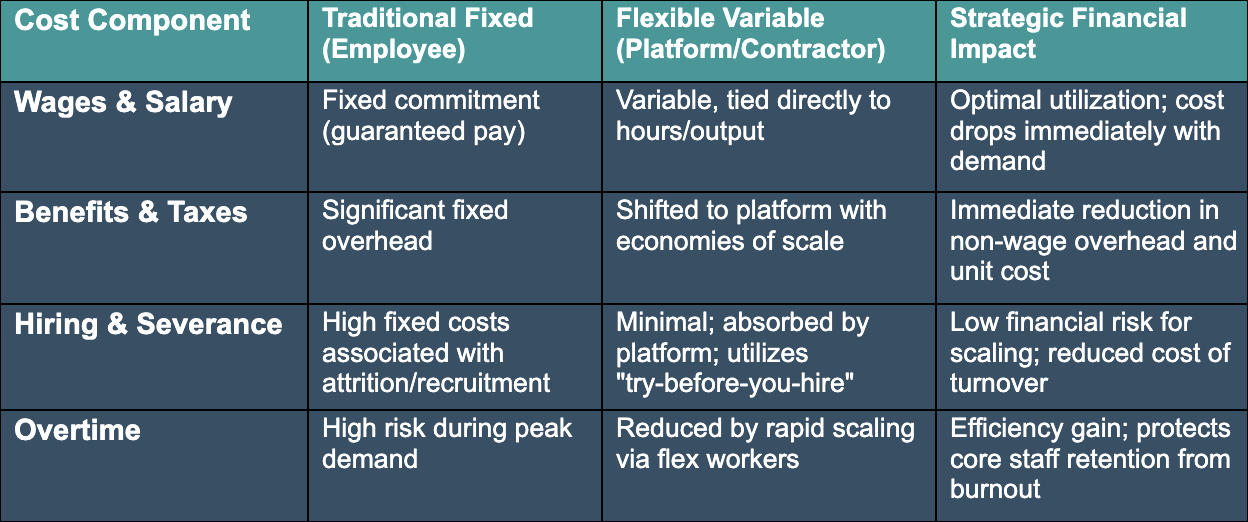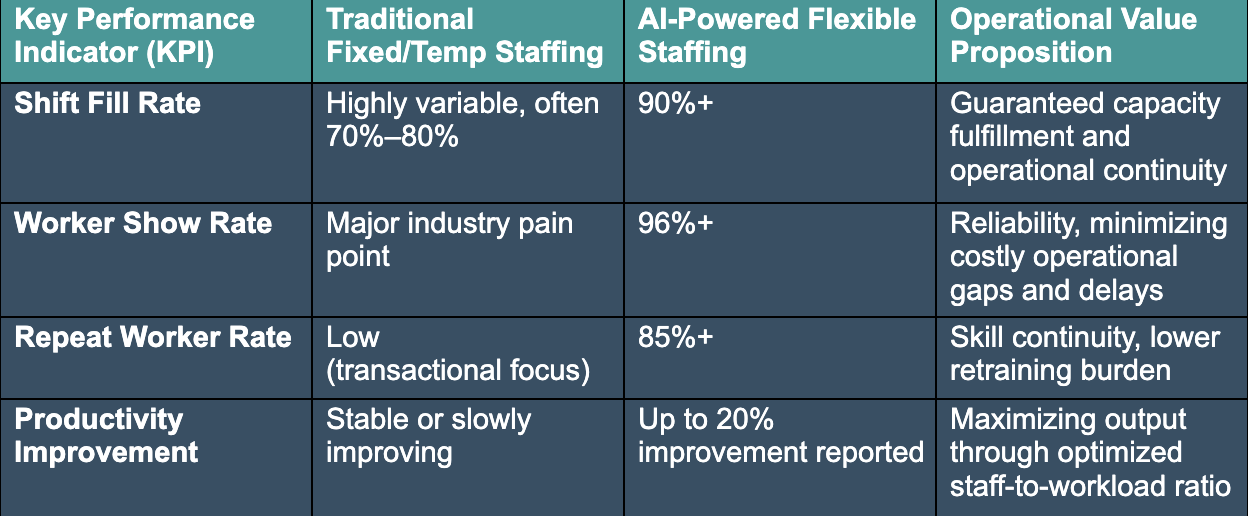The Mandate for Agility: Progressing from 'Low Hire, Low Fire' Stagnation to the 'No Hire, No Fire' Operating Model

The Mandate for Agility: Progressing from 'Low Hire, Low Fire' Stagnation to the 'No Hire, No Fire' Operating Model

The prevailing "low hire, low fire" labor market, characterized by a risk-averse strategy, presents a facade of stability. However, this approach significantly impedes economic dynamism, the seamless integration of talent, and overall growth, particularly within sectors experiencing high employee turnover. This cautious stance, while seemingly safe, stifles innovation and agility by making organizations hesitant to bring in new skills or adapt to changing market demands.
To navigate the current landscape of economic uncertainty and the rapid technological shifts driven by the rapid adoption of AI, organizations must fundamentally transform their labor models.
A more flexible, AI-platform-enabled "no hire, no fire" model is essential. This paradigm shift converts labor from a fixed overhead to a managed variable cost. By leveraging AI-powered, full-stack labor platforms, companies can optimize workforce allocation, scale up or down efficiently, and access specialized skills on demand without the long-term commitments of traditional employment while still giving workers financial security and career opportunities, provided by the platform.
The Stagnation Imperative: Deconstructing the "Low Hire, Low Fire" Trap
We are in a low hire, low fire labor market.
-US Federal Reserve Chairman, Jerome Powell, September 2025
The reluctance of businesses to engage in either significant hiring or large-scale firing has created a stagnant economic gridlock defined by managerial conservatism. Every new permanent role is treated as a major, high-risk commitment due to potential severance costs, discouraging necessary job mobility and restricting the efficient reallocation of talent across the economy. This fixed behavior has detrimental macroeconomic consequences that challenge the perceived stability of the current market. For instance, the low unemployment rate of 4.3% in recent data conceals a deepening structural weakness: a surge in long-term unemployed workers. Labor data indicates that the share of Americans that have been unemployed for 27 weeks or longer has risen sharply to 26%, representing 1.9 million people who are struggling to re-enter the job market.
This low-hiring environment acts as a restrictive barrier, leading to human capital atrophy and risking a mass exodus of discouraged workers from the labor force. Furthermore, stagnation hinders crucial trial-and-error, stifling innovation and growth. Treating labor as a high-friction, fixed cost makes firms risk-averse, limiting experimentation and adaptability to disruptions like AI. This "low-hiring, low-firing" mode is unsustainable, risking catastrophic job market deterioration in a downturn, as it is leaving millions behind.
The Generational Imperative: Barriers to Gen Z Integration
The rigid employment structure underpinning the "low hire, low fire" market also creates a profound misalignment with the values and expectations of the emerging Gen Z workforce, which is poised to become the largest segment of the labor market by 2035.
Gen Z, defined by its tech-savviness and pragmatic outlook, approaches careers differently than prior generations. These workers prioritize a trifecta of values: money, meaning, and well-being, placing a high priority on work/life balance, learning, and development. They are not primarily motivated by the traditional climb up the corporate ladder, with only 6% citing reaching a leadership position as their main career goal. They have come of age in a world characterized by disruption and impermanence and thus possess an expectation of constant change, making them naturally flexible and resilient.
However, traditional fixed roles often demand rigid hours, long tenure commitments, and often fail to provide adequate development opportunities, directly clashing with these values. This structural incompatibility is a major driver of the industrial recruitment crisis; sectors like manufacturing and logistics struggle to attract young workers, despite the modernization of these fields with AI and cutting-edge technologies. Only 14% of surveyed American Gen Z workers reported considering industrial work.
The solution lies in fFlexible staffing platforms, crucial for attracting Gen Z talent. Platforms offering flexible scheduling, immediate pay, and diverse experiences appeal to Gen Z's desire for autonomy and growth. This "try-before-you-hire" model de-risks entry for both employers and young workers, fostering exploration, skill development, and innovation.
The Financial Revolution: Turning Labor into a Variable Cost

The most critical strategic advantage of progressing to a "no hire, no fire" model, facilitated by full-stack labor platforms, is the fundamental shift of labor from a fixed overhead cost to a fully variable expense. This structural change is the cornerstone of financial resilience and agility.
The Strategic Advantage of Variable Cost Labor
Traditional organizations view salaried employees as fixed costs, regardless of performance or demand. In contrast, by turning to a model that supports hourly labor as a variable cost, businesses can align expenses with demand and revenue, providing financial agility. High fixed labor costs introduce risk, leading to layoffs during downturns. A variable labor pool, sourced via platforms, allows businesses to scale down without severance costs or morale erosion. The "no hire, no fire" model protects margins through dynamic operational leverage. Classifying labor as a variable cost increases contribution margin, allowing companies to absorb revenue shocks and market volatility, making them more resilient. This model also enhances efficiency; reducing labor hours is simple during low demand, and rapid scaling during peak demand prevents expensive overtime. Modern platforms use AI and machine learning to predict staffing needs, preventing overstaffing and optimizing the cash-to-production ratio.
Quantifying Cost Elimination: Overhead vs. Engagement
The transition to a flexible, variable model eliminates a substantial basket of fixed overhead costs associated with traditional employment, providing significant savings after factoring in the associated costs that aren’t obvious based on the initial higher hourly rates for contingent workers.
The primary savings categories include:
- Administrative and overhead costs: Businesses reduce expenses related to recruitment time and cost, employee benefits (medical, pension, and vacation), payroll taxes, unemployment insurance contributions, and the physical overhead required for full-time staff (office space and utilities).
- Minimizing failure costs: The cost of replacing a salaried employee can be equivalent to up to nine months of their salary. Utilizing flexible roles, particularly "temp-to-hire" placements, acts as a low-risk trial period. This structural change fundamentally de-risks the talent acquisition pipeline by reducing the chance of an expensive bad fixed hire.
- Eliminating overtime spikes: In high-churn industries, managing unpredictable volume spikes using fixed staff often results in expensive, mandatory overtime. Flexible staffing solutions fill capacity gaps strategically before overtime becomes necessary. Organizations leveraging this strategy report significant financial benefits due to better alignment between staffing levels and actual workload demands.
The financial contrast underscores the imperative for this strategic shift:

Quality and Operational Excellence in High-Churn Industries
A traditional managerial hesitation regarding flexible labor is the perceived trade-off between flexibility and quality control. However, modern, AI-powered "no hire, no fire" platforms have implemented rigorous performance management systems that not only maintain but often surpass the reliability of traditional staffing models, especially in high-churn, operational sectors like warehousing and events.
Mitigating Churn Risk with Platform Accountability
In rapidly changing environments, platforms ensure reliability by using data to predict worker performance (e.g., analyzing 150+ factors) and deploying only vetted, certified talent. They enforce accountability with immediate consequences, like a 3-strike policy for cancellations and automated blocking of no-shows, leading to high show (96%+) and fill rates (90%+). This contrasts with slow, expensive traditional methods. This system creates high return rates for workers (up to 85%+), retaining operational knowledge, minimizing training, and building a loyal, skilled talent pool. Flexible workers also absorb demand peaks, reducing burnout and improving retention for core staff.
Quantified Operational Success Metrics
Flexible staffing boosts operational execution and service quality by matching staff to fluctuating demand. This optimizes staff-to-workload ratios, preventing understaffing (stress, dissatisfaction) and overstaffing (budget overruns), leading to up to a 20% productivity improvement. It also provides on-demand access to niche skills without long-term commitment.

Strategic Implementation and Risk Mitigation

Successfully implementing a "no hire, no fire" model requires cultural integration. The efficiency of a flexible workforce can be undermined if contingent workers feel isolated. Therefore, deliberate cultural strategies are crucial for integrating a hybrid workforce. Since long-term tenure is less of a motivator, especially for Gen Z, company culture must prioritize immediate engagement, shared purpose, and transparent communication, ensuring temporary staff feel valued. Providing similar training and professional development opportunities to contingent workers as permanent staff is also essential.
This keeps flexible talent skilled and engaged, addressing Gen Z’s demand for continuous learning. This can be easily provided by the platform, especially for GenZ. As a concrete example, in September of 2025, 26% of Gen Z workers became max earners on the WorkWhile platform, working more than 40 hrs a week, up from 16% in September of 2024, a 62.5% increase in just one year, as they found continuous upskilling opportunities and work diversity on the platform.
Conclusion
The "low hire, low fire" market leads to rigid, inefficient businesses, ill-suited for modern volatility and future workforce needs. The "no hire, no fire" model, enabled by AI-powered flexible labor platforms, offers a mandatory strategic shift. By turning labor into a non-fixed cost, organizations gain financial agility, ensuring profitability by aligning expenditure with output. This eliminates fixed overhead, mitigates hiring risks, and ensures quality through data-driven performance. The result is operational supremacy: high fill rates, reliability, and up to 20% productivity improvements. Executives must embrace this optimized, fractional workforce ecosystem for speed, quality, and financial stability in a constantly changing era.

